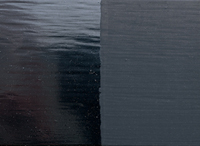 CAUSES: Stains on cedar and redwood are due mainly to moisture and to insufficient priming. Certain types of cedar and redwood "bleed" through paint. Moisture carries water-soluble color extractives (tannic acid) contained in the wood through the film. Staining is more visible when light or medium colors are used.
CAUSES: Stains on cedar and redwood are due mainly to moisture and to insufficient priming. Certain types of cedar and redwood "bleed" through paint. Moisture carries water-soluble color extractives (tannic acid) contained in the wood through the film. Staining is more visible when light or medium colors are used.
Two patterns of tannin bleed can occur; their appearances indicate the source of the moisture. Rain, dew, humidity or faulty roof drainage cause water to penetrate the paint film from the front of siding creating diffused discoloration. Water-based house paints also can leach out tannic acid and cause diffused discoloration.
Rundown or streaky discoloration occurs when water finds it way behind the siding.
SOLUTIONS: First, the source of moisture should be located and corrected. Remove loose or cracked caulking and repair with a quality product. Avoid caulks that can crack, shrink or lose adhesion. Clean out nearby gutters and downspouts. Then, wash the stained surface with a commercial-grade bleach solution, rinse with a pressure washer (available from your local independent dealer) and allow the surface to dry thoroughly for at least 48 hours.
Prime the dry wood. Special water-thinned primers formulated to seal-in stains are available; alkyd oil-based primers are recommended by some manufacturers, as are some acrylic latex stain-blocking primers. In cases of severe staining, use two coats of primer before top coating. A waiting period of at least 48 hours after application is recommended before applying the second coat and/or the finish coat.
Most tannic acid stains will penetrate the first coat of primer in seven days leaving a brownish spot or ring. If stains do occur, re-prime the stained spot, allow to dry thoroughly and apply the finish coat. It's a good idea to prime board or siding shingle edges and ends. If possible, back-prime prior to installation. These procedures will forestall moisture from entering the wood. If staining occurs during application, sand lightly and re-prime before applying the final finish.
NOTE: In spite of all precautions, a certain amount of bleeding is likely to occur during the first year. It is worth waiting through this period before painting because surface deposits often weather away or can be washed off with detergent and water.






































